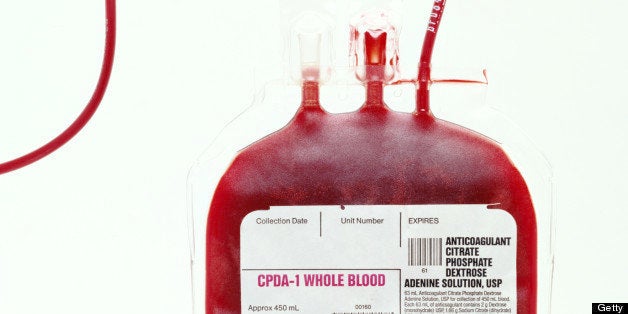
In 1977 the Food and Drug Administration enacted a policy that prevents men who have had sex with other men from donating their blood to official blood banks. Today, nearly 36 years later, a performance artist named Mary Coble will question the implications of this policy by painting with a pint of her own "acceptable" blood at the Corcoran Gallery in Washington D.C.
Coble's performance piece, entitled "Deferral," examines the controversial FDA rule and the ramifications of the language hidden within it. Over the course of four days, Coble and a group of men who self-identify as gay will adorn hospital curtains at the gallery with words, codes and images referencing the highly debated policy text.
Coble herself will write the word "deferral" in morse code, each bloodied dot referencing an actual pin prick or a drop of blood. The men surrounding her won't be using sanguine fluid though. Instead, they'll work in red thread, referencing the "illegal" quality of their own blood. The performance questions the rule's messy rhetoric and the exclusive idea of heroism associated with the act of donating blood.
We reached out to Coble for more information on the performance:

How did you form the concept for "Deferral"?
I was invited by the Corcoran to do a performance and instead of reenacting one I had already done I decided to do this. I like to take the location and the context into consideration whenever I do a piece. So I was thinking about Washington DC and The Corcoran, which has very specific architecture, with an atrium and two floors. I had been interested in exploring the FDA's rule that men who have had sex with men cannot donate blood-- an interest in queer issues of social injustice threads throughout my work. The white house is across from The Corcoran as is the Red Cross-- and so everything just came together.
In The Corcoran, if you go up onto the second floor you can look down into the atrium. What I am doing is blocking off the bottom atrium with hospital screens. You can see something happening on the screens if you are downstairs but you have to go to the second floor to get a full picture of what is going to be happening. It sort of reflects anatomical or medical theaters of the past, where the people in power peer down at the specimens, making the viewer implicit in the act of watching.
What role does superhero imagery play in the work?
The FDA's ruling -- that is kind of the seed of the project, but I am also concerned with a lot of the slogans advertising blood donation -- Be a hero, Feel proud, Feel fierce, Don't be a wuss. I think these slogans can be really problematic because it insinuates that men who have sex with men shouldn't feel proud, aren't allowed to be heroes. Part of my thesis is exploring how gay men are never allowed to be heroes in a mainstream society. I am trying to hint at a different kind of hero, perhaps. So when the gay men are performing with me, they will be stitching outlines of heroes onto the curtains, reforming or reshaping the outline with their stitches along the way. It's about reclaiming or questioning what a hero can be. I'm also addressing the language of we, together, united -- who is the we that we are talking about who are we leaving out?
What are you hoping the piece will achieve politically?
I would consider myself and artist and an activist; there is no hierarchy in my mind of one over another. I do hope someone comes in and is intrigued enough to stay and dig through the layers of the work. So many people are not aware that men who have sex with men are not allowed to donate blood. I hope to raise some awareness of institutional homophobia, and how it affects not just the queer community but everyone. Ultimately this piece could relate to anyone-- gay, straight, it comes down to treating each other as equals. All human beings are deserving the same rights as others.
What performance artists did you look to for inspiration?
I am interested in a lot of the 1970s female performance artists. A lot of them utilized endurance in their work -- a slower paced performance that built up over time. This is a four day piece and there is no moment of climax. It will change every hour every day but there is no moment of shock or climax.
"Deferral" will run August 7 from 10-9 p.m. August 8-10 from 10-5 p.m. at the Corcoran Gallery of Art. Let us know your thoughts in the comments.

